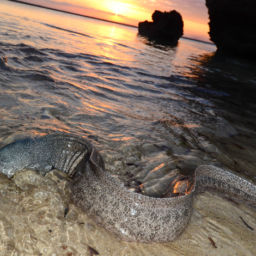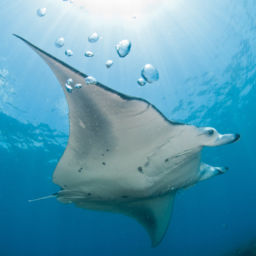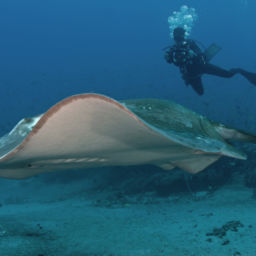The East African nation of Mozambique features almost 1,500 miles (2,300 km) of coastline along the Indian Ocean. And, thanks to all this oceanfront real estate, there’s amazing diving along the entire coast. Some areas, such as Ponta Malongane/Ponta Do Ouro are popular with divers who flock in from neighboring South Africa, especially during South African school holidays. In other areas, such as Pomene and the Bazaruto Archipelago, you’ll likely have the reef to yourself. The best scuba diving in southern Mozambique offers a little bit of everything: both macro life and megafauna like mantas and whale sharks. And although tourism is still a burgeoning industry in this developing nation, you’ll be glad you made the effort once you arrive. Here’s how to make a trip to southern Mozambique a reality.
Getting to and around in Mozambique
Tourism in Mozambique is still a growing industry. This makes it a bit more difficult to get around compared to destinations like Thailand or Indonesia. While inexpensive local chapas, a form of local transportation that could range from a minivan to an open-bed truck, and buses travel along the coast daily, they are not always the most reliable or safest forms of transport. Major bus companies and privately-owned shuttles make trips from South Africa along the major highway leading north into Mozambique if you’re arriving overland. You can also take a private taxi from the airport in Maputo to your hotel. Or, for those who like a little more adventure, you also rent a car in Maputo or South Africa for a self-drive journey.
Although the EN1 highway that runs through Mozambique is tar road, a four-wheel-drive vehicle is best for the roads leading off the highway to the coast. Many of these roads are dirt roads, some with soft beach sand — all adding to your Mozambican adventure. The speed limit in Mozambique is 100km/h (62 mph) outside of towns with 80/60 km/h (50/37 mph) in towns. Police strictly monitor speed limits, readily giving fines for transgressions, so drive carefully. Add several extra hours to your travel time, no matter the destination, as everything in Mozambique is very much on African time.
You can reach many dive destinations by flying to a nearby airport and then either taking a taxi or arranging for airport pickup from your hotel. As with the roads, flights and airports also work on African time so be prepared for your journey to take longer than you planned.
When to go
Rainy season falls between December and March and it can get quite humid during this period. From June to October the weather is pleasant, with June to August being the coolest months. Winter in Mozambique is still warm, with temperatures during the day ranging from around 80 to 86 F (27 to 30 C). Cyclone season is from February to May, although usually this time of the year has mostly calm weather and cyclones seldom affect the coast of Mozambique.
Note that Mozambique is a malarial area, so take precautions with anti-malaria medication, mosquito nets and bug spray.
Scuba diving in southern Mozambique
There are dive destinations all up and down the coast. We’ve chosen a few of the country’s best sites, arranged below from south to north as you leave the capital of Maputo, and split into two articles, as there are so many to choose from. Here are our first four picks.
Ponta do Ouro and Ponta Malongane
Where is it: Ponta do Ouro and Ponta Malongane are located just a few miles from the South African border at Kosi Bay. The two areas are linked by around five miles (8 km) of beach-sand roads.
What makes it special: Whale sharks, dolphins, barracuda, reef sharks and eagle rays are abundant here. You’ll also see a wide variety of tropical fish, frogfish, paper fish, nudibranchs and schools of redtoothed triggerfish. Divers have also spotted Zambezi and hammerhead sharks. Dive sites are available for both beginners and more experienced divers.
Details: You can reach Ponta either by driving up through South Africa or via Maputo. Driving from Maputo could take between 3 to 5 hours while driving from Johannesburg in South Africa could take between 8 to 10 hours, depending on how busy the border is. The best option would be to rent a car in either South Africa or Maputo and self-drive. Ponta do Ouro is the ‘town,’ where you’ll find restaurants, a number of dive operators, accommodation and an ATM. Malongane is a bit more remote but s till has accommodation and a dive center. These areas share the same reef system, so you can stay in Ponta Do Ouro town or have a quiet break in Malongane.
When to go: Diving is good all year with water temperatures around 72 F (22 C) in the winter (June through August) and 79 F (26 C) in the summer (November to February). Reef depth varies from 30 to 130 feet (10 to 40 m), offering diving for divers from all levels. Visibility varies from 30 to 100 feet (10 to 30 m) and can change drastically from day to day.
Ponta Mamoli
Where is it: Ponta Mamoli is more secluded than do Ouro and Malongane, located 60 miles (100 km) south of Maputo and 15 miles (25 km) from the Kosi Bay border post, one of four between South Africa and Mozambique.
What makes it special: There is a diverse population of gobies, blennies, wrasse, nudibranchs and hermit crabs. Don’t miss the cave filled with Indian glassy fish and lionfish and a chance to see leopard shark and harlequin shrimp. Large white cowries are scattered about with many cleaning stations.
Details: Reach Ponta Mamoli by driving from either South Africa or Maputo in a rental car or taxi. It will take 4 to 6 hours driving from Maputo and 9 to 11 hours driving from Johannesburg. One hotel in the area offers luxury accommodation and diving.
When to go: Diving is good all year with water temperatures varying from 72 F (22 C) in the winter to 79 F (26 C) in the summer. Reef depth varies from 29 to 130 feet (9 to 40 m), offering diving for divers from all levels. Visibility varies from 30 to 100 feet (10 to 30 m).
Inhaca Island
Where is it: Inhaca Island is 22 miles (35 km) offshore from Maputo.
What makes it special: This 20-square-mile (52 km2), inhabited island offers a vast diversity of marine life, with over 150 different types of healthy coral and large schools of barracuda and kingfish. You’ll often see dolphins, whale sharks and manta rays during the summer and humpback whales often hang around between September and November.
Inhaca Island also features several dive-able wrecks, with some shallow enough to snorkel at. Reefs average around 18 meters with some going down to 30 meters, offering plentiful good diving to all levels of certification.
Details: A ferry between Maputo and Inhaca leaves once a day and takes around two hours. There are several options for accommodations and dive operators on the island.
When to go: Diving is good all year with water temperatures varying from 72 F (22 C) in the winter to 79 F (26 C) in the summer. Reef depths vary from 30 to 115 feet (10 to 35 m), offering something divers from all levels. Visibility varies from 30 to 100 feet (10 to 30 m).
Zavora
Where is it: The area of Zavora is about 250 miles (400 km) north of Maputo.
What makes it special: Zavora is truly is one of the undiscovered gems of Mozambique. Zavora has two wrecks, the Klipfontein for tech divers, lying between 114 and 130 feet (35 to 40 m), and the Rio Sainos, lying at 82 to 100 feet (25 to 35 m) that’s great for advanced divers. You are likely to see schools of batfish, sharks, turtles and eels. Mantas, frogfish and paper fish populate the cleaning station. And from June to November, you may spot humpback whales.
Details: You can reach either by driving up from Maputo or flying to Inhambane and then driving South to Zavora. Drive time from Maputo ranges between 6 and 8 hours, while driving from Inhambane takes about 1 to 2 hours.
When to go: Diving is good all year with water temperatures varying from 75 F (24 C) in the winter to 84 F (29 C) in the summer. Reef depths vary from 40 to 130 feet (12 to 40 m), offering something for divers from all levels. Visibility varies from 30 to 100 feet (10 to 30 m).










